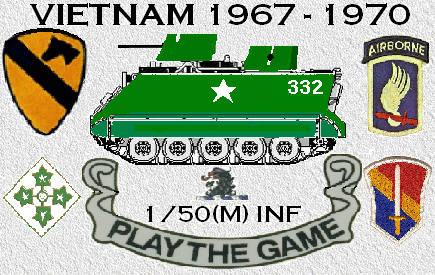

WHAT'S NEW?
2. Instructions
3. Quiz No. 2. M16 Rifle
4. Send in your questions!

|
 |
WHAT'S NEW? 2. Instructions 3. Quiz No. 2. M16 Rifle 4. Send in your questions! |
|
1st Battalion, 50th Infantry"Play the Game" |
|
Background on the M16 RifleThe M16A1 was the standard U.S. Infantry weapon during the Vietnam War. Marred by teething problems when first introduced, the key advantages of massive firepower and lightweight ammunition made it a formidable weapon once modifications were sorted out.The specification for a small caliber weapon was raised in 1957, and two rifle designs were produced for testing in 1958. The Winchester-Western Division of Olin Matieson Corporation produced a .224 Winchester lightweight military rifle. The Armalite Division of Fairchild Engine and Airplane Corporation produced the AR-15. Following the tests, Winchester ceased work and Fairchild (Armalite) sold the rights to the AR-15 in December 1959 to Colt's Patent Fire Arms Manufacturing Company, Inc.for $75,000 plus 4.5% royalties. In 1960 the US Air Force tested the AR-15 at Lackland Air Force Base, Texas, as a replacement for the U.S. Carbine, Caliber .30, M2 as the standard weapon for security guards and other limited use. In 1962, after additional testing and modifications, the Air Force adopted the AR-15 and redesignated it as the M16 rifle. Colt was also able to get the Department of Defense's Advanced Research Project Agency (ARPA) to test 1,000 weapons in its Vietnam-oriented Project Agile. An enthusiastic report led to more studies from the Department of Defense and the Department of the Army, and in November 1963 despite strong Army opposition, Defense Secretary McNamara ordered 85,000 M16's for Vietnam for use by airborne, air assault, and special forces units. 19,000 were also ordered for the Air Force. Extensive Army before and before accepting the M16 required a number of modifications, the most noticeable being addition of a forward assist assembly to enable soldiers to manually close the bolt. Nevertheless, it was felt that the M16 with its light weight and short length was ideally suited for the tropical warfare encountered in the jungles of Southeast Asia. Field tests proved that the M16 rifle was well suited for tropical warfare, but more modifications were required. Modifications were complete by February 1967, and the M16 rifle was accepted as a standard service weapon and redesignated the M16A1. Early reports from Vietnam by the Ordnance Corps showed that the M16 was not living up to expectations, with both reliability and accuracy problems. These reports praised the M14 which the Ordnance Corps had developed, and the dispute prompted McNamara to seek independent evaluation of both weapons. Further evaluation concluded that M14 was not as bad as had been suggested by some although it was heavier and troops couldn't carry as much ammunition, while the M16 itself was not as good as its proponents suggested. Basically, problems were twofold: the rifle jammed if not kept extremely clean and troops were neither trained nor equipped to clean it When these problems were belatedly addressed with the M16A1, the rifle performed well and is now the longest serving infantry weapon in U.S. history. The current version, the M16A2 was issued in 1991 and the M4 Carbine version was adopted in 1994. |
|||||||||||||||||
InstructionsHow much do you remember about the M16? Take this quiz and see.For the answers, please click on the button at the end of the test. Good luck! |
|||||||||||||||||
|
|||||||||||||||||
Submit your 1/50th, Vietnam War and Nam-era Trivia!Email your trivia items and corrections to this quiz to 1/50(M) Trivia. Please include answers. :-) |